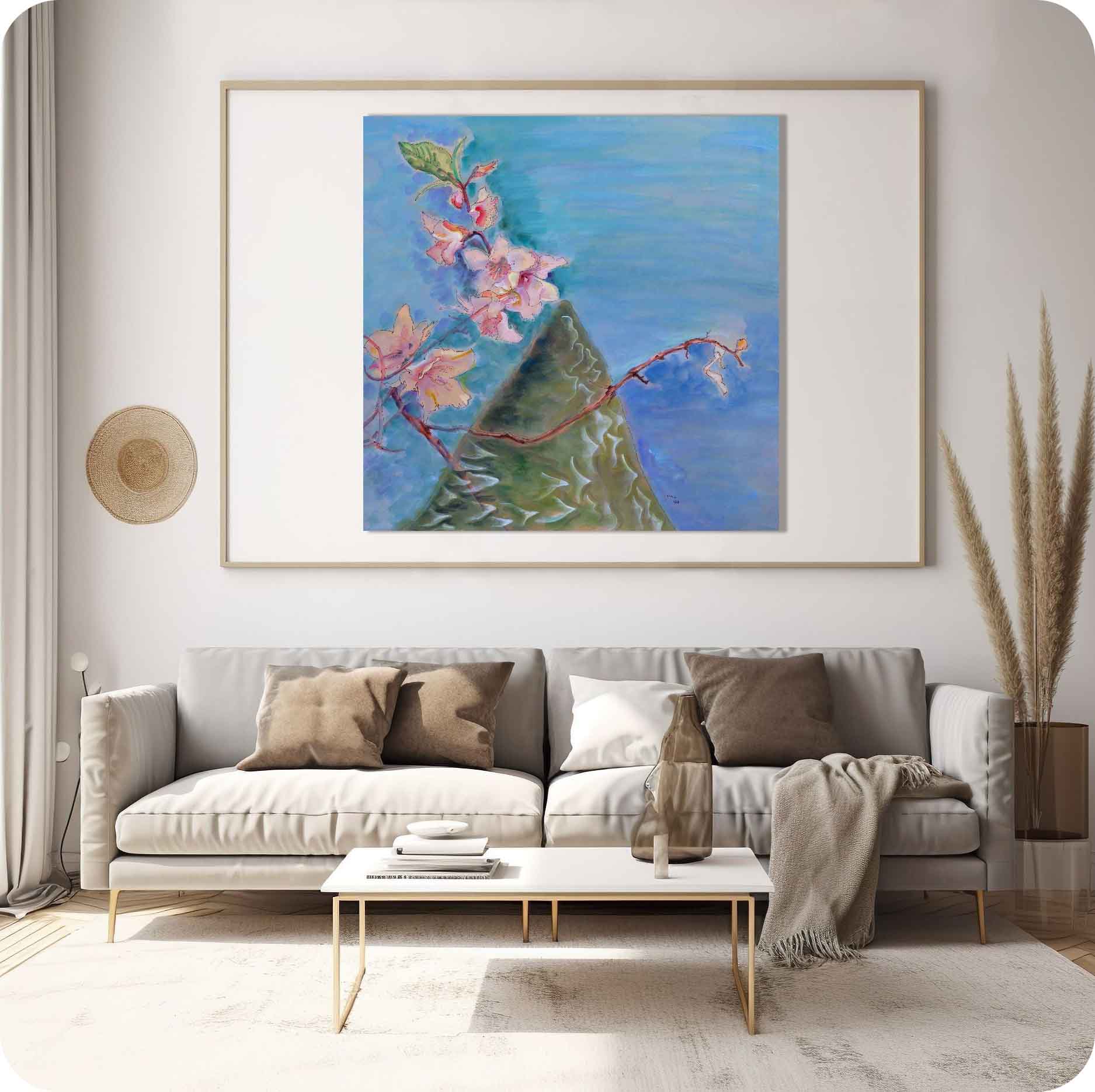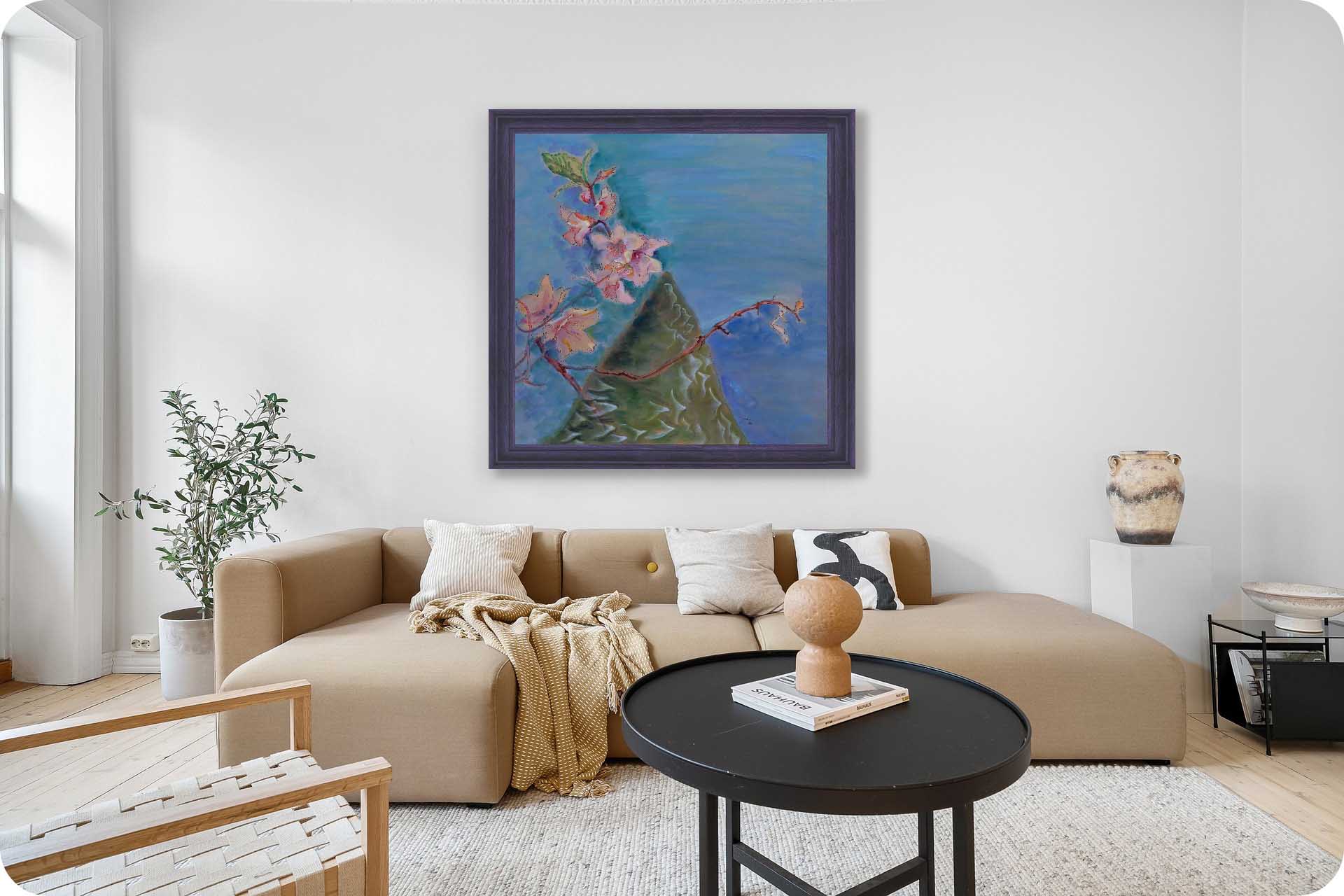The theme of this year's painting clearly states one - the makeup of desire. People's various desires are wrapped under various makeups. Desires are the intertwining of happiness and pain in life. Either straightforward or subtle, they will appear in makeup, forming a profound look of an era.
If spring is compared to a person, then beauty is the desire of spring, desire is the action of "loneliness", and flowers are the makeup of "desire".
Inches: 23.6 x 23.6 in
Size without the frame: 60 x 60 cm
Country: China
Date: 2024
Materials: Acrylic paint on Panel
Condition: well preserved
Creative themes and style | My works revolve around the creative concept of "The land of humanity, People on the land".The people in the painting are people in nature, and the lines, shapes, and colors are close to nature. The nature in the painting is nature in the eyes of humans, existing in interaction with humans.I don’t pursue a series of works with a fixed and continuous style. I hope that the style of the pictures will synchronize with the changes in my life and always remain oscillating. The performance of the work must be in sync with the development of one's own life in order to be Sincere and powerful.Ideas are later.
An Interview with Artist Philo by Artphiloso Gallery
If you would like to collect this artwork or know more about the artist, please contact us.s


Atmosphere and Artistic Language
This painting constructs a unique spiritual field of spring through an implicit and poetic artistic language. The pink blossoms, rendered with watercolor blending techniques, possess a soft, translucent texture. Their delicacy, combined with the stretching motion of the branches and leaves, conveys the vitality of spring. However, against the vast expanse of blue in the background, a subtle undertone of loneliness emerges, complicating the sense of renewal.
Visual Anchor and Formal Contrast
At the center, the green rock stands out through its distinctive textural modeling, resembling the traces of time etched into nature. It functions as a visual anchor, connecting the flowers with the surrounding environment. The solidity of the rock disrupts the lightness of the blossoms and the haziness of the background, creating a formal contrast. Its presence suggests a solitary barrier amidst the exuberance of spring, evoking a paradox between vibrancy and isolation.
Symbolic and Surreal Insertions
On the right, the slender dead branch introduces a stark interruption, while the tiny human-like figure clinging to it becomes a surreal symbol. This figure, caught between fragility and resilience, seems to be searching or contemplating, embodying the inner solitude of the individual. Through this insertion, the painting materializes an abstract sense of autism—a wandering soul suspended between blossoming vitality and an infinite, indifferent expanse.
Symbolist Techniques and Metaphorical Depth
The artist employs symbolist techniques, where spring flowers symbolize the passion of life, while the rock and dead branch metaphorically represent constraints and loneliness within reality. The interweaving of warm pinks and cool blues heightens the collision between vitality and solitude. In terms of form, the softness of the flowers, the rigidity of the rock, and the smallness of the human figure within a vast natural setting create a layered emotional structure.
Emotional Resonance
Every detail is a profound exploration of the contradictions inherent in spring. Viewers are invited to experience how beauty and loneliness coexist, and how visual imagery becomes a translation of complex human emotions. This painting offers a meditation on the fragility of existence, touching on the universal resonance of being both embraced by nature’s renewal and alienated within it.
Lin Fengmian, Spring Day
Uses landscapes and flowers to create a serene, poetic atmosphere, blending hazy colors into a meditative vision of spring.
Odilon Redon, Bouquet
Presents flowers against an illusory background, merging natural motifs with surreal romance and symbolic mystery.
Kaii Higashiyama, Blue Echo
Integrates plants with broad, natural color fields, establishing a tranquil, lyrical mood marked by silence and reflection.
Sanyu, Pink Lotus
Depicts the softness of flowers with minimalist composition and gentle hues, producing a poetic, understated elegance.
The artwork features a blue-green background as the main tone, where a bold, towering mountain form contrasts with a horizontally stretching flower branch. The mountain’s solidity and the flower’s lightness intertwine within the same frame, breaking away from the typical singularity of floral painting. This creates a unique compositional tension of “strength and delicacy combined.”
The background is composed of softly layered shades of blue and teal, with natural gradations that evoke the merging of sky and water. The blossoms, painted in soft pink, white, and light lavender, are accented with touches of warm yellow at the center. This interplay allows the artwork to radiate a subtle warmth against its predominantly cool color palette, giving it a luminous and balanced visual effect.
The heaviness of the mountain and the delicacy of the flowers create a striking contrast that symbolizes a dialogue between permanence and transience, strength and beauty. The branch extending across the mountain feels like living nature responding to timeless existence, evoking a poetic image of “blossoms blooming on the mountainside, as silent years pass by.” This carries a profound sense of Eastern philosophy and poetic reflection.
As a piece of “contemporary landscape floral decorative art,” it is ideal for display in modern studies, tea rooms, or cultural exhibition spaces that aim to create a serene atmosphere. The combination of floral romance with the gravity of mountains infuses the space with a mood of contemplation and harmony with nature. This makes it especially appealing to collectors who appreciate Eastern aesthetics.
This work stands out as a “contemporary landscape floral fusion artwork” that goes beyond decoration to explore the dialogue between nature and life. Its blend of aesthetic appeal and philosophical depth gives it lasting value in the art market. As a result, it holds strong potential for both long-term appreciation and investment, making it an excellent choice for those seeking “Oriental poetic art investment.”
A: Click here to view ARTPHILOSO's Guide for Collectors.
More paintings from this series:
Symptoms of loneliness in spring 1 Symptoms of loneliness in spring 2
Symptoms of loneliness in spring 3 Symptoms of loneliness in spring 4
Symptoms of loneliness in spring 5 Symptoms of loneliness in spring 6
